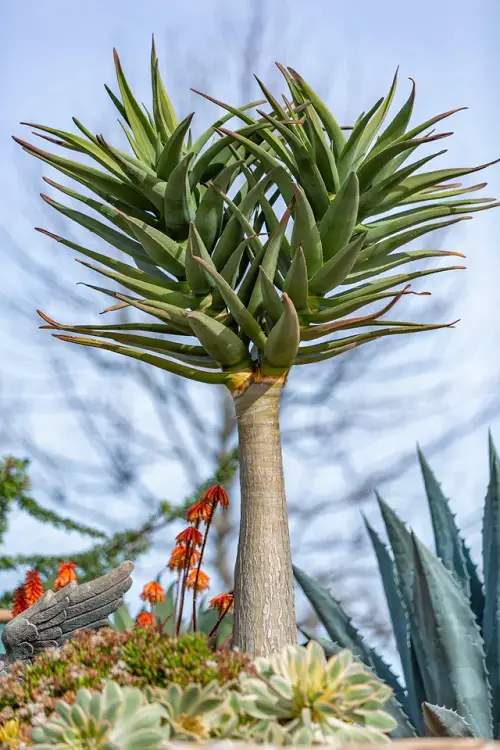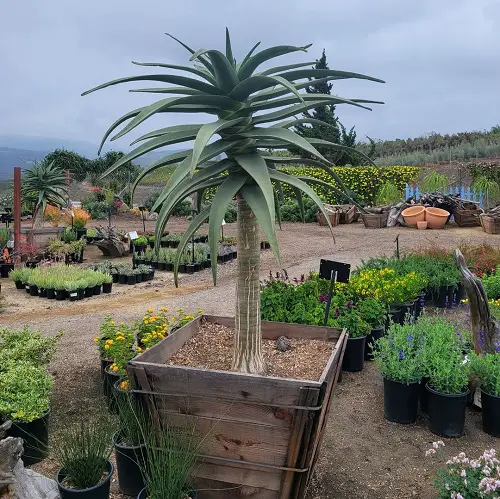Aloe Hercules Care is not difficult if you follow the right direction! Read on to learn how to grow this beautiful succulent easily!

If you want to grow an easy-to-care succulent that attains a good height and looks the part, then read on to learn about Aloe Hercules Care!
Have a look at Plants that Look like Aloe Vera
Aloe Hercules Plant Information
The Aloe Hercules is a species of succulent plant native to South Africa. It is a member of the genus Aloe, which includes over 500 species of plants.
This large, fast–growing succulent has a rosette of thick, fleshy, gray–green leaves with serrated edges. The leaves are arranged in a spiral pattern and can reach up to 3 feet in length. It produces yellow–orange flowers in the summer.
Look at the Best Types of Aloe
How to Propagate Aloe Hercules

You can propagate Aloe Hercules through cuttings and offsets instead of seeds. Nursery-bought plants are also a good option.
To propagate this succulent from a cutting, use a sharp blade and cut a healthy stem, allow it to callous, and plant it in a cactus or succulent mix. Water well and keep the pot where it gets plenty of dappled light.
Best Container Size for Aloe Hercules
You can start the plant in an 8-10-inch container and then keep on re-potting depending on its spread and growth.
Read How to Propagate Aloe Vera from Pups + Force it to Grow More Pups
Requirements for Growing Aloe Hercules

Location
Aloe Hercules requires full sun to partial shade. It prefers at least 6 to 8 hours of direct sunlight per day in order to grow and thrive. It can tolerate some shade, but this will limit its growth and flowering potential.
Soil
It is best grown in well–draining, sandy soil that is slightly acidic. Cactus and succulent potting mixes are available from most garden centers and provide the perfect soil for growing Aloe Hercules.
Adding a small amount of organic compost to the soil will help the Aloe Hercules retain moisture and nutrients.
Water
Aloe Hercules is a low-maintenance succulent that does not need a lot of water. It prefers the soil to be moist but not wet, so it is best to water it when it starts to dry out.
The soil should be allowed to dry out between waterings, and the roots should not be allowed to sit in water for extended periods of time.
It is also important to ensure that the container has adequate drainage. Over–watering can cause root rot and other problems.
Temperature
This aloe is native to tropical and subtropical climates. It prefers temperatures between 55°F (13°C) and 80°F (27°C). It can tolerate temperatures as low as 40°F (4°C) for short periods of time.
Learn How to Grow Climbing Aloe Indoors as a Vine
Aloe Hercules Care

Fertilizer
Aloe Hercules plants are low maintenance and don’t require much fertilizer. A light application of a balanced fertilizer every two to three months should be enough to keep your plant looking healthy.
You can use a liquid or a slow-release fertilizer once in 7-8 weeks. Make sure to follow the directions on the label for proper application and dilution of the fertilizer.
Always water your plant before applying the fertilizer to ensure that the roots get the most benefit from it. Avoid over-fertilizing your plant, leading to leaf discoloration and even death.
Overwintering
When overwintering Aloe Hercules, it is important to keep it in a cool, dry location. The plant should be kept from direct sunlight, and temperatures should not drop below 50°F (10°C).
Watering should be reduced during the winter months, and only enough to keep the soil slightly moist. If the plant is exposed to temperatures below 40°F (4°C), it should be covered with a heavy blanket. Fertilizing should be avoided during the winter months.
Pests and Diseases
Mealybugs, aphids, and scales can attack Aloe Hercules. Use insecticidal soap or rubbing alcohol directly on the affected part using a cotton swab.
It can be impacted by fungal diseases such as powdery mildew and root rot, bacterial diseases such as crown rot and black spot, and viruses such as aloe mosaic virus.


